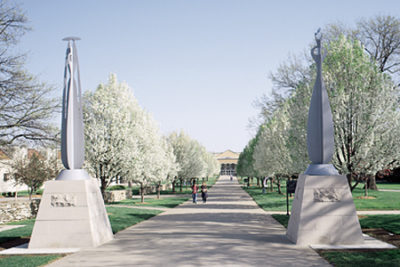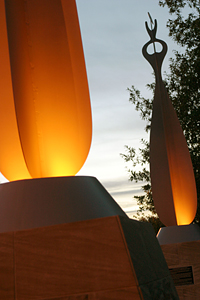The Alexander Archipenko abstract sculptures of UMKC
Try this.
Walk along the sidewalk on 51st Street until you come to the spot where Holmes Street deadends and the wide walkway leads north to the Student Center. Look up, side to side, at the two tall sculptures that flank the walkway.
Study each one carefully. Do you notice that one of the abstract sculptures curves and twists this way, and the other one bends and arches that way? The cap on top of one is a flat-wedge and on top of the other it’s arrow-thin.
Stylistically similar but individually distinctive, you’re thinking.
But you are wrong. What you think you see is not reality.
The sculptures are exactly the same. They are only mounted differently. The two painted, sheet-iron pieces are rotated ninety degrees from each other to give the appearance of two different but related sculptures.
The Artist
The artist was Alexander Archipenko (1887-1964). His two untitled pieces, which he called “Ornaments,” were completed in 1951. They were the first abstract sculptures installed in Kansas City.
By the time the Ukrainian-born Archipenko arrived at the University of Kansas City’s art department in 1950 as artist-in-residence, he was already an acclaimed 20th century sculptor. He had introduced new aesthetic elements to modern sculpture, such as modeling of space, and he had experimented in the use of unique materials for sculptures. An early work, the Médrano II, had movable parts and was made of tin, wood and glass. It is now part of the Solomon R. Guggenheim Museum collection.
Juan Gris, the Spanish painter and sculptor and a contemporary of Archipenko, said, “Archipenko challenged the traditional understanding of sculpture. It was generally monochromatic at the time. His pieces were painted in bright colors. Instead of accepted materials such as marble, bronze or plaster, he used mundane materials such as wood, glass, metal, and wire. His creative process did not involve carving or modeling in the accepted tradition but nailing, pasting and tying together, with no attempt to hide nails, junctures or seams. His process parallels the visual experience of cubist painting.”
At the age of 21, Archipenko moved to Paris and studied briefly at I’Ecole des Beaux-Arts. He was a member of the Section d’Or group, which included the Duchamp brothers, Pablo Picasso and Guillaume Apollinaire. In 1910, Archipenko’s first one-man show was mounted in Hagen, Germany, and he opened his own art school in Paris. Other schools — in Berlin, New York and Woodstock — followed in the 1920s.
When he came to the U.S. in 1923, Archipenko said, “America is the only country not jaded and rent by war. It is the land where the great art of the future will be produced. America fires my imagination more than any other country and embodies more of that flexibility, that yeastiness, which means life and vitality and movement.”
In 1929, the artist became a U.S. citizen.
Archipenko’s work as a sculptor and teacher included residencies at institutions around the country. He was at Washington State University, 1935-1936, and at the New Bauhaus, Chicago, 1937. During the 1950s, he taught and lectured at many U.S. universities, including the University of Kansas City (UMKC) in 1950.
“In teaching,” said Archipenko, “I make my students realize the necessity of applying the psychological process for the discovery of creative reactions within themselves before they make the form which should contain creative power. This is a fundamental knowledge that vitalizes the work of art.”
For more information about Archipenko and to view more of his work, visit http://www.archipenko.org.


